Republic F-84 Thunderjet
The Republic F-84 Thunderjet was an American turbojet fighter-bomber aircraft. Originating as a 1944 United States Army Air Forces (USAAF) proposal for a "day fighter", the F-84 first flew in 1946. Although it entered service in 1947, the Thunderjet was plagued by so many structural and engine problems that a 1948 U.S. Air Force review declared it unable to execute any aspect of its intended mission and considered canceling the program. The aircraft was not considered fully operational until the 1949 F-84D model and the design matured only with the definitive F-84G introduced in 1951. In 1954, the straight-wing Thunderjet was joined by the swept-wing F-84F Thunderstreak fighter and RF-84F Thunderflash photo reconnaissance aircraft.
| F-84 Thunderjet | |
|---|---|
 | |
| USAF F-84E Thunderjet | |
| Role | Fighter-bomber |
| Manufacturer | Republic Aviation |
| First flight | 28 February 1946 |
| Introduction | November 1947 |
| Retired | 1964 (USAF) 1974 (Yugoslavia) |
| Primary user | United States Air Force |
| Number built | 7,524 |
| Unit cost |
US$237,247 (F-84G)[1] US$769,330 (F-84F) |
| Variants | Republic F-84F Thunderstreak Republic XF-84H Thunderscreech Republic XF-91 Thunderceptor |
The Thunderjet became the USAF's primary strike aircraft during the Korean War, flying 86,408 sorties and destroying 60% of all ground targets in the war as well as eight Soviet-built MiG fighters. Over half of the 7,524 F-84s produced served with NATO nations, and it was the first aircraft to fly with the U.S. Air Force Thunderbirds demonstration team. The USAF Strategic Air Command had F-84 Thunderjets in service from 1948 through 1957.
The F-84 was the first production fighter aircraft to utilize inflight refueling and the first fighter capable of carrying a nuclear weapon, the Mark 7 nuclear bomb. Modified F-84s were used in several unusual projects, including the FICON and Tom-Tom dockings to the B-29 Superfortress and B-36 bomber motherships, and the experimental XF-84H Thunderscreech turboprop.
The F-84 nomenclature can be somewhat confusing. The straight-wing F-84A to F-84E and F-84G models were called the Thunderjet. The F-84F Thunderstreak and RF-84F Thunderflash were different airplanes with swept wings. The XF-84H Thunderscreech (not its official name) was an experimental turboprop version of the F-84F. The F-84F swept wing version was intended to be a small variation of the normal Thunderjet with only a few different parts, so it kept the basic F-84 number. Production delays on the F-84F resulted in another order of the straight-wing version; this was the F-84G.
Design and development

In 1944, Republic Aviation's chief designer, Alexander Kartveli, began working on a turbojet-powered replacement for the P-47 Thunderbolt piston-engined fighter. The initial attempts to redesign the P-47 to accommodate a jet engine proved futile due to the large cross-section of the early centrifugal compressor turbojets. Instead, Kartveli and his team designed a new aircraft with a streamlined fuselage largely occupied by an axial compressor turbojet engine and fuel stored in rather thick unswept wings.[1]
On 11 September 1944, the USAAF released General Operational Requirements for a day fighter with a top speed of 600 mph (521 kn, 966 km/h), combat radius of 705 miles (612 nmi, 1,135 km), and armament of either six 0.50 in (12.7 mm) or four 0.60 in (15.2 mm) machine guns. In addition, the new aircraft had to use the General Electric TG-180 axial turbojet which entered production as the Allison J35.
On 11 November 1944, Republic received an order for three prototypes of the new XP-84—Model AP-23.[1] Since the design promised superior performance to the Lockheed-built P-80 Shooting Star and Republic had extensive experience in building single-seat fighters, no competition was held for the contract. The name Thunderjet was chosen to continue the Republic Aviation tradition started with the P-47 Thunderbolt while emphasizing the new method of propulsion. On 4 January 1945, even before the aircraft took to the air, the USAAF expanded its order to 25 service test YP-84As and 75 production P-84Bs (later modified to 15 YP-84A and 85 P-84B).
Meanwhile, wind tunnel testing by the National Advisory Committee for Aeronautics revealed longitudinal instability and stabilizer skin buckling at high speeds.[1] The weight of the aircraft, a great concern given the low thrust of early turbojets, was growing so quickly that the USAAF had to set a gross weight limit of 13,400 lb (6,080 kg). The results of this preliminary testing were incorporated into the third prototype, designated XP-84A, which was also fitted with a more powerful J35-GE-15 engine with 4,000 lbf (17.79 kN) of thrust.[1]
The first prototype XP-84 was transferred to Muroc Army Air Field (present-day Edwards Air Force Base) where it flew for the first time on 28 February 1946 with Major Wallace A. "Wally" Lien at the controls. It was joined by the second prototype in August, both aircraft flying with J35-GE-7 engines producing 3,745 lbf (16.66 kN). The 15 YP-84As delivered to Patterson Field (present-day Wright-Patterson Air Force Base) for service tests differed from XP-84s by having an upgraded J35-A-15 engine, carrying six 0.50 in (12.7 mm) M2 Browning machine guns (four in the nose and one in each wing root), and having the provision for wingtip fuel tanks holding 226 U.S. gal (856 L) each.
Due to delays with delivery of jet engines and production of the XP-84A, the Thunderjet had undergone only limited flight testing by the time production P-84Bs began to roll out of the factory in 1947. In particular, the impact of wingtip tanks on aircraft handling was not thoroughly studied. This proved problematic later.[1]
After the creation of the United States Air Force by the National Security Act of 1947, the Pursuit designation was replaced with Fighter, and the P-84 became the F-84.
F-84s were assigned to the 27th Fighter Wing, 27th Fighter Escort Wing, 27th Strategic Fighter Wing, 31st Fighter Escort Wing, 127th Fighter Day Wing, 127th Fighter Escort Wing, 127th Strategic Fighter Wing, 407th Strategic Fighter Wing and the 506th Strategic Fighter Wing of the Strategic Air Command from 1947 through 1958.[2]
Operational history
The F-84B, which differed from YP-84A only in having faster-firing M3 machine guns, became operational with 14th Fighter Group at Dow Field, Bangor, Maine in December 1947. Flight restrictions followed immediately, limiting maximum speed to Mach 0.8 due to control reversal, and limiting maximum acceleration to 5.5 g (54 m/s²) due to wrinkling of the fuselage skin. To compound the problem, parts shortages and maintenance difficulties earned the aircraft the nickname, "Mechanic's Nightmare".[1] On 24 May 1948, the entire F-84B fleet was grounded due to structural failures.

A 1948 review of the entire F-84 program discovered that none of the F-84B or F-84C aircraft could be considered operational or capable of executing any aspect of their intended mission. The program was saved from cancellation because the F-84D, whose production was well underway, had satisfactorily addressed the major faults. A fly-off against the F-80 revealed that while the Shooting Star had a shorter takeoff roll, better low altitude climb rate and superior maneuverability, the F-84 could carry a greater bomb load, was faster, had better high altitude performance and greater range.[1] As a temporizing measure, the USAF in 1949 committed US$8 million to implement over 100 upgrades to all F-84Bs, most notably reinforcing the wings. Despite the resultant improvements, the F-84B was withdrawn from active duty by 1952.[1]
The F-84C featured a somewhat more reliable J35-A-13 engine and had some engineering refinements. Being virtually identical to the F-84B, the C model suffered from all of the same defects and underwent a similar structural upgrade program in 1949. All F-84Cs were withdrawn from active service by 1952.[1]
The structural improvements were factory-implemented in the F-84D, which entered service in 1949. Wings were covered with thicker aluminum skin, the fuel system was winterized and capable of using JP-4 fuel, and a more powerful J35-A-17D engine with 5,000 lbf (22.24 kN) was fitted. It was discovered that the untested wingtip fuel tanks contributed to wing structural failures by inducing excessive twisting during high-"g" maneuvers.[1] To correct this, small triangular fins were added to the outside of the tanks. The F-84D was phased out of USAF service in 1952 and left Air National Guard (ANG) service in 1957.[1]
The first effective and fully capable Thunderjet was the F-84E model which entered service in 1949. The aircraft featured the J35-A-17 engine, further wing reinforcement, a 12 in (305 mm) fuselage extension in front of the wings and 3 in (76 mm) extension aft of the wings to enlarge the cockpit and the avionics bay, an A-1C gunsight with APG-30 radar, and provision for an additional pair of 230 gal (870 L) fuel tanks to be carried on underwing pylons.[1] The latter increased the combat radius from 850 to 1,000 miles (740 to 870 nmi; 1,370 to 1,610 km).
One improvement to the original F-84 design was rocket racks that folded flush with the wing after the 5-inch HVAR rockets were fired, which reduced drag over the older fixed mounting racks. This innovation was adopted by other U.S. jet fighter-bombers.[3]
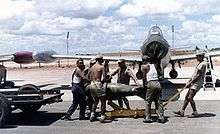
Despite the improvements, the in-service rates for the F-84E remained poor with less than half of the aircraft operational at any given time.[1] This was primarily due to a severe shortage of spares for the Allison engines. The expectation was that F-84Es would fly 25 hours per month, accumulating 100 hours between engine overhauls. The actual flight hours for Korean War and NATO deployments rapidly outpaced the supply and Allison's ability to manufacture new engines.[1] The F-84E was withdrawn from USAF service in 1956, lingering with ANG units until 1959.
The definitive straight-wing F-84 was the F-84G which entered service in 1951. The aircraft introduced a refueling boom receptacle in the left wing,[4] autopilot, Instrument Landing System, J35-A-29 engine with 5,560 lbf (24.73 kN) of thrust, a distinctive framed canopy (also retrofitted to earlier types), and the ability to carry a single Mark 7 nuclear bomb.[1] The F-84G was retired from USAF in the mid-1960s.
Starting in the early 1960s, the aircraft was deployed by the Força Aérea Portuguesa (FAP) during the Portuguese Colonial War in Africa. By 1972, all four operating F-84 aircraft were supplementing the FAP in Angola.[5]
Flying the Thunderjet
Typical of most early jets, the Thunderjet's takeoff performance left much to be desired. In hot Korean summers with a full combat load, the aircraft routinely required 10,000 ft (3,000 m) of runway for takeoff even with the help of RATO bottles (two or four of these were carried, each producing 1,000 lbf (4.4 kN) of thrust for 14 seconds).[1] All but the lead aircraft had their visibility obscured by the thick smoke from the rockets. Early F-84s had to be pulled off the ground at 160 mph (140 kn, 260 km/h) with the control stick held all the way back. Landings were made at a similar speed, for comparison the North American P-51 Mustang landed at approximately 120 mph (100 kn, 190 km/h). Despite the "hot" landing speeds, the Thunderjet was easy to fly on instruments and crosswinds did not present much of a problem.[6]

Thanks to the thick straight wing the Thunderjet rapidly reached its Mach 0.82 limitation at full throttle and low altitude. The aircraft had sufficient power to fly faster, but exceeding the Mach limit at low altitudes resulted in a violent pitch-up and structural failure causing the wings to break off.[6] Above 15,000 ft (4,600 m), the F-84 could be flown faster but at the expense of severe buffeting. However, the airspeed was sufficiently easy to control to make safe dive bombing from 10,000 ft (3,000 m) possible.[6] The top speed limitation proved troublesome against Soviet Mikoyan-Gurevich MiG-15s in Korea. Slower than the MiG, the F-84 was also unable to turn tightly with a maximum instantaneous-turn load of only 3 Gs followed by rapid loss of airspeed. One F-84E pilot credited with two MiG kills achieved his second victory by intentionally flying his aircraft into pitch-up.[6] The MiGs chasing him were unable to follow the violent maneuver and one crashed into the ground. Luckily for the F-84E pilot, the aircraft did not disintegrate but the airframe did suffer heavy warping. The F-84 was a stable gun platform and the computing gunsight aided in accurate gunnery and bombing. Pilots praised the aircraft for Republic's legendary ruggedness.[6]
Pilots nicknamed the Thunderjet "The Lead Sled".[2] It was also called "The Iron Crowbar", "a hole sucking air", "The Hog" ("The Groundhog"), and "The World's Fastest Tricycle", "Ground Loving Whore" as a testament to its long takeoff rolls.[2] F-84 lore stated that all aircraft were equipped with a "sniffer" device that, upon passing V2, would look for the dirt at the end of the runway. As soon as the device could smell the dirt, the controls would turn on and let the pilot fly off the ground. In the same vein, it was suggested a bag of dirt should be carried in the front landing gear well. Upon reaching V2, the pilot would dump the dirt under the wheels, fooling the sniffer device.[2]
Korean War
The Thunderjet had a distinguished record during the Korean War. Although the F-84B and F-84C could not be deployed because their J35 engines had a service life of only 40 hours, the F-84D and F-84E entered combat with 27th Fighter Escort Group on 7 December 1950.[1] The aircraft were initially tasked with escorting the B-29 Superfortress bombers. The first Thunderjet air-to-air victory was scored on 21 January 1951 at the cost of two F-84s.[2] The F-84 was a generation behind the swept-wing Soviet Mikoyan-Gurevich MiG-15 and outmatched, especially when the MiGs were flown by more-experienced pilots, and the MiG counter-air mission was soon given to the F-86 Sabre. Like its famous predecessor, the P-47, the F-84 switched to the low-level interdiction role at which it excelled.
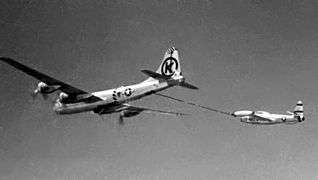
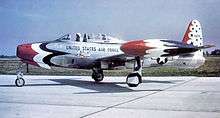
The F-84 flew a total of 86,408 missions, dropping 55,586 tons (50,427 metric tons) of bombs and 6,129 tons (5,560 metric tons) of napalm.[2] The USAF claimed F-84s were responsible for 60% of all ground targets destroyed in the war. Notable F-84 operations included the 1952 attack on the Sui-ho Dam. During the war, the F-84 became the first USAF fighter to utilize aerial refueling. In aerial combat, F-84 pilots were credited with eight MiG-15 kills against a Soviet-claimed loss of 64 aircraft. The total losses were 335 F-84D, E and G models.[2] According to USAF FY1953, during the Korean war, 358 F-84s were lost, including 249 in combat missions and 109 non-combat losses.[7]
Portuguese Overseas War
In 1961, the Portuguese Air Force sent 25 of their remaining F-84G to Angola. There they formed the Esquadra 91 (91st Squadron), based at Luanda Air Base. From then on, the F-84s were engaged in the Angolan Theater of the Portuguese Overseas War, being mainly employed in air strike missions against the separatist guerrillas.
The last F-84 were kept operational in Angola until 1974.
Notable achievements
- The F-84 was the first aircraft flown by the U.S. Air Force Thunderbirds, which operated F-84G Thunderjets from 1953 to 1955 and F-84F Thunderstreaks from 1955 to 1956. The F-84E was also flown by the Skyblazers team of United States Air Forces Europe (USAFE) from 1950 to 1955.[1]
- On 7 September 1946, the second XP-84 prototype set a national speed record of 607.2 mph (527.6 kn, 977.2 km/h), slightly slower than the world record 612.2 mph (532.0 kn, 985.2 km/h) held by the British Gloster Meteor.[1]
- On 22 September 1950, two EF-84Es, flown by David C. Schilling and Col. William Ritchie, flew across the North Atlantic from Great Britain to the United States. Ritchie's aircraft ran out of fuel over Newfoundland but the other successfully made the crossing which took ten hours two minutes and three aerial refuelings. The flight demonstrated that large numbers of fighters could be rapidly moved across the Atlantic.[1]
- F-84G was the first fighter with built-in aerial refueling capability and the first single-seat aircraft capable of carrying a nuclear bomb.[1]
- On 20 August 1953, 17 F-84Gs using aerial refueling flew from the United States to the United Kingdom. The 4,485-mile (3,900 nmi, 7,220 km) journey was the longest-ever nonstop flight by jet fighters.[1]
- In 1955, an F-84G became the first aircraft to be zero-length launched from a trailer.[8]
By the mid-1960s, the F-84/F-84F was replaced by the F-100 Super Sabre and the RF-84F by the RF-101 Voodoo in USAF units, being relegated to duty in the Air National Guard. The last F-84F Thunderflash retired from the ANG in 1971. Three Hellenic Air Force RF-84Fs that were retired in 1991 were the last operational F-84s.
Costs
| F-84B | F-84C | F-84D | F-84E | F-84G | F-84F | RF-84F | |
|---|---|---|---|---|---|---|---|
| Airframe | 139,863 | 139,863 | 150,846 | 562,715 | 482,821 | ||
| Engine | 41,654 | 41,654 | 41,488 | 146,027 | 95,320 | ||
| Electronics | 7,165 | 7,165 | 4,761 | 9,623 | 21,576 | ||
| Armament | 23,559 | 23,559 | 37,433 | 41,713 | 63,632 | ||
| Ordnance | 2,719 | 9,252 | 4,529 | ||||
| Flyaway cost | 286,407 for the first 100 163,994 for the next 141 | 147,699 | 212,241 | 212,241 | 237,247 | 769,300 | 667,608 |
| Cost per flying hour | 390 | ||||||
| Maintenance cost per flying hour | 185 | 185 |
Notes: The costs are in approximately 1950 United States dollars and have not been adjusted for inflation.[1]
Variants
Straight-wing variants

- XP-84
- The first two prototypes.
- XP-84A
- The third prototype with a more powerful J35-GE-15 engine. This airframe was subsequently modified with a pointed fairing over the intake and lateral NACA intakes were installed into the intake trunks.
- YP-84A
- Service test aircraft; 15 built.
- P-84B (F-84B)
- First production version, J35-A-15 engine; 226 built.
- F-84C
- Reverted to the more reliable J35-A-13 engine, improved fuel, hydraulic and electrical systems; 191 built.
- F-84D
- J35-A-17 engine, various structural improvements. The pitot tube was moved from the tail fin to the splitter in the air intake with fins added to the wingtip fuel tanks; 154 built.
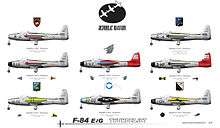
- EF-84D
- Two F-84Ds, EF-84D 48-641 and EF-84D 48-661 were modified with coupling devices; 641 starboard wing, 661 port wing for "Tip-Tow Project MX106 Wing Coupling Experiments." An EB-29A 44-62093 was modified with coupling devices on both wings. Because of the difference in landing gear lengths, the three aircraft took off separately and couple/uncoupled in flight. The pilot of 641 was Major John M. Davis and the pilot of 661 was Major C.E. "Bud" Anderson.
- "One of the more interesting experiments undertaken to extend the range of the early jets in order to give fighter protection to the piston-engine bombers, was the provision for inflight attachment/detachment of fighter to bomber via wingtip connections. One of the several programs during these experiments was done with a B-29 mother ship and two F-84D 'children', and was code named 'Tip Tow'. A number of flights were undertaken, with several successful cycles of attachment and detachment, using, first one, and then two F-84s. The pilots of the F-84s maintained manual control when attached, with roll axis maintained by elevator movement rather than aileron movement. Engines on the F-84s were shut down in order to save fuel during the 'tow' by the mother ship, and inflight engine restarts were successfully accomplished. The experiment ended in disaster during the first attempt to provide automatic flight control of the F-84s, when the electronics apparently malfunctioned. The left hand F-84 rolled onto the wing of the B-29, and the connected aircraft both crashed with loss of all on board personnel (Anderson had uncoupled so did not crash with the other two aircraft)."[9]
- F-84E
- J35-A-17D engine, Sperry AN/APG-30 radar-ranging gunsight, retractable attachments for RATO bottles, inboard wing hardpoints made "wet" to permit carrying an additional pair of 230 U.S. gal (870 L) fuel tanks. Most aircraft were retrofitted with F-84G-style reinforced canopies. The fuselage was stretched 15"; the canopy was lengthened 8", the canopy frame was lengthened 12" (accounting for another 4"), and a 3" splice panel was added aft of the canopy. The stretch was not done to enlarge the cockpit but rather to enable a larger fuel tank, provide additional space for equipment under the canopy behind the pilot's seat, and to improve aerodynamics. This can be distinguished from earlier models by the presence of two fuel vents on ventral rear fuselage, the added radar in the nose splitter, and the pitot tube was moved downward from mid-height in the splitter (as on the F-84D) to clear the radar installation. 843 built. F-84E 49-2031 was a test aircraft for air-to-air missiles. F-84E 50-1115 was a test aircraft for the FICON project.
- EF-84E
- Two F-84Es were converted into test prototypes, to test various methods of air-to-air refueling. EF-84E 49-2091 was used as a probe-and-drogue test aircraft. The probe was mid-span on the port wing. Production aircraft with probes (removable) had the probe fitted to the auxiliary wing tanks. EF-84E 49-2115 was used as a FICON test aircraft with a B-36 host. EF-84E 49-1225 and EF-84E 51-634 were test aircraft for the ZELMAL (Zero-length launch, Mat landing) experiments version for point defense, used the booster rocket from MGM-1 Matador cruise missile.
- F-84G
- Single-seat fighter-bomber capable of delivering the Mark 7 nuclear bomb using the LABS, J35-A-29 engine, autopilot, capable of inflight refueling using both the boom (receptacle in left wing leading edge) and drogue (probe fitted to wingtip fuel tanks), introduced the multi-framed canopy which was later retrofitted to earlier straight-winged F-84s. A total of 3,025 were built (1,936 for NATO under MDAP). The larger engine had a higher airflow at its take-off thrust than the intake had been designed for. This caused higher flow velocities, increased pressure losses and thrust loss. Commencing with block 20, auxiliary "suck-in" doors were added ahead of the wing leading edge to regain some of the thrust loss. At high engine rpm and low aircraft speeds, such as take-off, the spring-loaded doors were sucked open by the partial vacuum created in the duct. When the aircraft reached sufficient airspeed the ram pressure rise in the duct closed the auxiliary doors.[10] F-84G 51-1343 was modified with a periscope system to test the periscope installation proposed for the Republic XF-103.
- F-84KX
- Eighty ex-USAF F-84Bs converted into target drones for the United States Navy.
- RF-84G
- F-84G Thunderjets converted by France and Yugoslavia for recon duty with cameras in the ventral fuselage and modified auxiliary wing tanks.
- YF-96A aka YF-84F aka YRF-84K
- F-84E 49-2430 converted to swept wing configuration. The "first prototype" for the F-84F Thunderstreak. Canopy and ventral speed brake carried over from Thunderjet. Originally with a V-windscreen, later reverted to the standard Thunderjet flat windscreen. Modified by adding a fixed hook at the weapons bay and anhedral horizontal tailplane to enable FICON tests (trapeze capture) with GRB-36D mother ship. The airframe was capable of higher speeds than the Thunderjet engine could deliver. The YF-84F was a follow on with a larger engine and deepened fuselage.
- YF-84F
- F-84G 51-1344 converted to swept wing configuration. The "second prototype" for the F-84F Thunderstreak. Fuselage deepened by 7 inches (180 mm) to accommodate larger engine. Canopy and ventral speed brake carried over from Thunderjet, tail configuration same as YF-96A.
- YF-84F aka YRF-84F
- F-84G 51-1345 converted to swept wing configuration with a pointed nose and lateral intakes. This was a test airframe to evaluate the effects of moving the intakes to the wing roots. Like 1344, the fuselage was deepened by 7 inches (180 mm) to accommodate larger engine. Canopy and ventral speed brake carried over from Thunderjet, tail configuration same as YF-96A. For the swept wing versions of the F-84 series, see Republic F-84F Thunderstreak
- Tip-Tow
- See EF-84D above, did not become operational. See FICON project
- Tom-Tom
- Two RF-84K and B-36 wingtip coupling experiment, did not become operational. See FICON project
- FICON
- F-84E and GRB-36D trapeze system, became operational. See FICON project
Swept-wing variants
- YF-84F
- Two swept-wing prototypes of the F-84F, initially designated YF-96A.
- F-84F Thunderstreak
- Swept wing version with Wright J65 engine.
- RF-84F Thunderflash
- Reconnaissance version of the F-84F, 715 built.
- RF-84K FICON project
- Reconnaissance version of the F model, 25 built to hang from the Consolidated B-36 Peacemaker.
- XF-84H Thunderscreech
- Experimental supersonic-turboprop version.
- YF-84J
- Two conversions with the General Electric J73 engine.
Operators
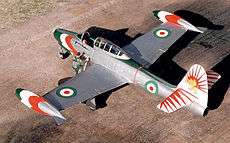

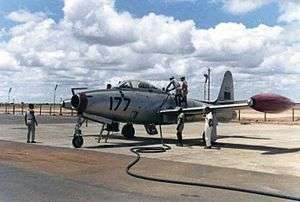
.svg.png)
- Belgian Air Force operated 213 Republic F-84G from March 1952 until September 1957 and 21 Republic RF-84E

- Danish Air Force operated 240 Republic F-84G from April 1952 until January 1962 and 6 Republic F-84E[11]

- French Air Force operated 335 F-84G from April 1952 until November 1956 and 46 Republic F-84E
.svg.png)
- Royal Hellenic Air Force operated 234 Republic F-84G from March 1952 until June 1960. They equipped the 335, 336, 337, 338, 339 and 340 Squadrons (Μοίρα Δίωξης)
- Imperial Iranian Air Force operated 69 Republic F-84G from May 1957 until September 1961

- Italian Air Force operated 256 Republic F-84G from March 1952 until May 1957[12][13]

- Netherlands Air Force operated 166 Republic F-84G from April 1952 until December 1957 and 21 Republic RF-84E. They equipped the 306, 311, 312, 313, 314, 315 and 316 Squadrons

- Norwegian Air Force operated 208 Republic F-84G from June 1952 until Jun 1960 and 6 Republic F-84E from 1951 until 1956 and 35 Republic RF-84F from 1956 until 1970

- Portuguese Air Force operated 125 Republic F-84G from January 1953 until July 1974
- Republic of China Air Force operated 246 Republic F-84G from June 1953 until April 1964

- Royal Thai Air Force operated 31 Republic F-84G from November 1956 until 1963

- Turkish Air Force operated 489 Republic F-84G from March 1952 until June 1966

- United States Air Force operated 226 Republic F-84B, 191 Republic F-84C, 154 Republic F-84D, 743 Republic F-84E, 789 Republic F-84G
.svg.png)
- Yugoslavian Air Force operated 231 Republic (R)F-84G from June 1953 until July 1974
Major USAF operational F-84 units

- 10th Tactical Reconnaissance Wing: RF-84F (1955–1958)
- 12th Fighter Escort Wing/Group: F-84E/G/F (1950–1957;1962–1964)
- 14th Fighter Wing/Group: P/F-84B (1947–1949)
- 15th Tactical Fighter Wing: F-84F (1962–1964)
- 20th Fighter Bomber Wing/Group: F-84B/C/D/E/F/G (1958–1959)
- 27th Fighter Escort Wing/Group: F-84E/G/F (1950–1958)
- 31st Fighter Escort Wing/Group: F-84C/E/F (1948–1950; 1951–1957)
- 49th Fighter Bomber Wing/Group: F-84E/G (1951–1953)
- 58th Fighter Bomber Group: F-84E/G (1952–1954)
- 66th Tactical Reconnaissance Wing: RF-84F (1955–1959)
- 67th Tactical Reconnaissance Wing: (15th & 45th TRS5) RF-84F/K (1955–1958)
- 71st Strategic Reconnaissance Wing: RF-84F/K (1955–1956)
- 81st Fighter Bomber Wing/Group: F-84F (1954–1959)
- 136th Fighter Bomber Wing/Group F-84E (1951–1952) @ K2, also J-13
- 312th Fighter Bomber Group: F-84E/G (1954–1955)
- 363rd Tactical Reconnaissance Wing: RF-84F (1954–1958)
- 366th Fighter Bomber Wing/Tactical Fighter Wing: F-84E,F (1954–1958;1962–1965)
- 401st Fighter Bomber Wing/Tactical Fighter Wing: F-84F (1957)
- 405th Fighter Bomber Wing/Tactical Fighter Wing: F-84F (1953–1956)
- 407th Strategic Fighter Wing: F-84F (1954–1957)
- 474th Fighter Bomber Wing: F-84D/E/G (1952–1953)
- 506th Strategic Fighter Wing: F-84F (1953–1957)
- 508th Strategic Fighter Wing: F-84F (1952–1956)
- 3540th Combat Crew Training Wing: F-84E (1952–1953)
- 3600th Combat Crew Training Wing: F-84D/E/G/F (1952–1957)
- Redesignated 4510th CCTW with F-84D/F (1958)
- 3645th Combat Crew Training Wing: F-84E/G (1953–1957)
- 4925th Test Group (Atomic): F-84E/F/G (1950–1963)
Royal Netherlands Air Force operational F-84 units
- JVS-2 (Jacht Vlieger School): RF-84E (1953)
- 306 Squadron: F-84G (1953–1954) / RF-84E (1954-1957)
- 311 Squadron: RF-84E (1951-1952) / F-84G (1952-1956)
- 312 Squadron: RF-84E (1951-1954) / F-84G (1952-1956)
- 313 Squadron: RF-84E (1953-1954) / F-84G (1953-1956)
- 314 Squadron: F-84G (1952-1956)
- 315 Squadron: F-84G (1952-1956)
Aircraft on display
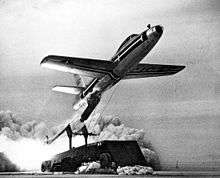
Denmark
- F-84G
- 51-9966/KR-A – Aalborg Defence and Garrison Museum, Aalborg[15]
- 51-10622/KU-U – Aalborg Defence and Garrison Museum[15]
- A-777/SY-H – Danmarks Tekniske Museum, Helsingør[16]
- KP-X – Danish Collection of Vintage Aircraft, Skjern[17]
- RF-84F
- C-581 – Flyvestation Karup Historiske Forening Museet, Karup[18]
- C-264 – Danish Collection of Vintage Aircraft, Skjern[17]
Norway
- F-84G
- 51-10161 – MU-Z, Flyhistorisk Museum, Sola, Stavanger Airport, Sola, near Stavanger.[21]
- 51-11209 – MU-5, Forsvarets flysamling Gardermoen, Oslo Airport, Gardermoen near Oslo.[22]
- 52-2912 - MU-J, Ørland Main Air Station
- 52-8465 – MU-P, Royal Norwegian Air Force Museum, Bodø[23]
Portugal
- F-84G
Serbia
- F-84G
Thailand

- F-84G
- 51-10582 Ex-USAF and retired Royal Thai Air Force fighter in Royal Thai Air Force Museum
Turkey

- F-84G
- 10572 – Istanbul Aviation Museum.
- 19953 – Atatürk Airport, İstanbul.
- RF-84F
- 1901 – Istanbul Aviation Museum.
- 1917 – Istanbul Aviation Museum.
United States
- YP-84A
- 45-59494 – Discovery Park of America, Union City, Tennessee. Formerly at Octave Chanute Aerospace Museum at the former Chanute Air Force Base in Rantoul, Illinois.[30][31]
- F-84B
- 45-59504 – Cradle of Aviation Museum in Garden City, New York.[32]
- 45-59556 – Planes of Fame Museum in Chino, California.[33]
- 46-0666 – Mid-Atlantic Air Museum in Reading, Pennsylvania.[34]
- F-84C
- 47-1433 – Pima Air and Space Museum, adjacent to Davis-Monthan Air Force Base in Tucson, Arizona.[35]
- 47-1486 – Goldwater Air National Guard Base, Sky Harbor International Airport in Phoenix, Arizona.[36]
- 47-1498 – EAA Airventure Museum in Oshkosh, Wisconsin.[37]
- 47-1513 – Kansas Aviation Museum at McConnell Air Force Base in Wichita, Kansas.[38]
- 47-1530 – Cannon Air Force Base, New Mexico.[39]
- 47-1562 – Pueblo Weisbrod Aircraft Museum in Pueblo, Colorado.[40]
- 47-1595 – March Field Air Museum at March Air Reserve Base (former March Air Force Base) in Riverside, California.[41]
- F-84E

- 49-2155 – Yanks Air Museum in Chino, California.[42]
- 49-2285 – Texas Military Forces Museum in Austin, Texas.[43]
- 49-2348 – American Airpower Museum in East Farmingdale, New York.[44]
- 50-1143 – National Museum of the United States Air Force at Wright-Patterson Air Force Base in Dayton, Ohio. It was obtained from Robins Air Force Base, Georgia, in October 1963.[45]
- 51-0604 – Museum of Aviation at Robins Air Force Base, Georgia.[46]
- F-84F
- 51-01748 - Delta County Airport, Escanaba, Michigan.[47]
- F-84G
- 51-0791 – Springfield Air National Guard Base, Springfield, Ohio.[48]
- 51-11126 - under restoration to airworthiness by a Vulcan Warbirds Inc. for the Flying Heritage Collection in Seattle, Washington.[49][50]
- 52-3242 – Hill Aerospace Museum, Hill Air Force Base, Utah.[51]
- 52-8365 - under restoration to airworthiness by a private owner in Edmonds, Washington.[52][53]
Specifications (F-84G Thunderjet)
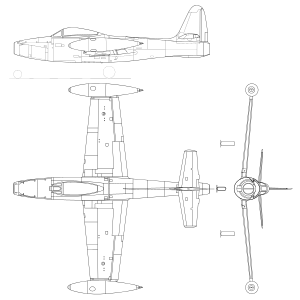
Data from Encyclopedia of US Air Force Aircraft and Missile Systems[1]
General characteristics
- Crew: 1
- Length: 38 ft 1 in (11.61 m)
- Wingspan: 36 ft 5 in (11.10 m)
- Height: 12 ft 7 in (3.84 m)
- Wing area: 260 sq ft (24 m2)
- Airfoil: Republic R-4,45-1512-.9 (12%)[54]
- Empty weight: 11,470 lb (5,203 kg)
- Gross weight: 18,080 lb (8,201 kg)
- Max takeoff weight: 23,340 lb (10,587 kg)
- Powerplant: 1 × Allison J35-A-29 turbojet engine, 5,560 lbf (24.7 kN) thrust
Performance
- Maximum speed: 622 mph (1,001 km/h, 541 kn)
- Maximum speed: Mach 0.81
- Cruise speed: 475 mph (764 km/h, 413 kn)
- Combat range: 1,000 mi (1,600 km, 870 nmi)
- Ferry range: 2,000 mi (3,200 km, 1,700 nmi) with external tanks
- Service ceiling: 40,500 ft (12,300 m)
- Rate of climb: 3,765 ft/min (19.13 m/s)
- Wing loading: 70 lb/sq ft (340 kg/m2)
- Thrust/weight: 0.31
Armament
- 6 × .50 in (12.7 mm) M3 Browning machine guns, 300 rpg
- Up to 4,450 lb (2,020 kg) of rockets and bombs, including 1 × Mark 7 nuclear bomb
Avionics
- A-1CM or A-4 gunsight with AN/APG-30 or Mk.18 ranging radar
See also
Related development
- F-84F Thunderstreak
- Republic XF-91 Thunderceptor
- XF-84H Thunderscreech
Aircraft of comparable role, configuration and era
- Dassault Ouragan
- de Havilland Venom
- Gloster Meteor
- Grumman F9F Cougar
- Grumman F9F Panther
- McDonnell XF-85 Goblin
References
Notes
- Knaack, Marcelle Size. Encyclopedia of US Air Force Aircraft and Missile Systems: Volume 1 Post-World War II Fighters 1945–1973. Washington, DC: Office of Air Force History, 1978. ISBN 0-912799-59-5.
- McLaren 1998
- "Rocket Racks Fold into Wing." August 1948, p. 92.
- "Mid-Air Refueling Increases Range of F-84 Thunderjet Fighters." Popular Mechanics, September 1951, p. 98, bottom page.
- "Força Aérea Portuguesa Dispositivo". Retrieved 9 March 2013.
- Higham, R. and C. Williams. Flying Combat Aircraft of USAAF-USAF (Vol.1). Rockville, Maryland: Air Force Historical Foundation, 1975. ISBN 0-8138-0325-X.
- https://www.alternatewars.com/BBOW/Stats/USAF_Losses_Korea.htm
- "Fighter Plane Launched Like Missile From Truck Platform." Popular Mechanics, March 1955, p. 108.
- Anderson, Major Clarence E. "Bud". "Aircraft Wingtip Coupling Experiments." Society of Experimental Test Pilots.
- https://docs.google.com/viewer?url=patentimages.storage.googleapis.com/pdfs/US2788184.pdf, column 2, para 5–17
- Schrøder, Hans (1991). "Royal Danish Airforce". Ed. Kay S. Nielsen. Tøjhusmuseet, 1991, p. 22. ISBN 87-89022-24-6.
- "Italian Air Force". aeroflight. Retrieved 31 May 2019.
- "Republic F 84G". Aeronautica Militare. Retrieved 31 May 2019.
- https://www.google.hr/maps/@45.220852,14.571417,3a,75y,90t/data=!3m8!1e2!3m6!1s21135171!2e1!3e10!6s%2F%2Fstorage.googleapis.com%2Fstatic.panoramio.com%2Fphotos%2Fsmall%2F21135171.jpg!7i2047!8i1360?hl=hr Retrieved: 19 October 2015.
- "Forsvars-og Garnisnsmuseum". Aviationmuseum. Retrieved 23 June 2016.
- "Danmarks Tekniske Museum". Retrieved 23 June 2016.
- "Danmarks Flymuseum". Retrieved 23 June 2016.
- "Flystation Karup HIstoriske Forening Museet". Retrieved 23 June 2016.
- "Republic F84G". Retrieved 22 November 2019.
- Jachtvliegtuig Republic F-84G 'Thunderjet' met registratienummer DU-24 Nationaal Militair Museum of the Netherlands, Retrieved: 14 October 2017.
- "F-84 Thunderjet/51-10161." aerialvisuals.ca Retrieved: 7 April 2015.
- "F-84 Thunderjet/51-11209." aerialvisuals.ca Retrieved: 7 April 2015.
- Republic F-84G Thunderjet Norse Luftfartsmuseum home page
- WEBTEAM, FAP-. "Força Aérea Portuguesa". www.emfa.pt (in Portuguese). Retrieved 1 February 2019.
- "1951 USAF Serial Numbers". www.joebaugher.com. Retrieved 1 February 2019.
- "F-84 Thunderjet/52-2936." www.paluba.info (not in English) Retrieved: 7 June 2015.
- "F-84 Thunderjet/52-2939." www.paluba.info (not in English) Retrieved: 7 June 2015.
- "F-84 Thunderjet/52-8365." www.paluba.info (not in English) Retrieved: 7 June 2015.
- "F-84 Thunderjet/52-2910." www.paluba.info (not in English) Retrieved: 7 June 2015.
- "USAF Serial Number Search (45-59494)". Retrieved 14 February 2018.
- "Aerial Visuals Airframe Dossier (45-59494)". Retrieved 11 March 2018.
- "F-84 Thunderjet/45-59504." Archived 16 December 2014 at the Wayback Machine Cradle of Aviation Museum. Retrieved: 13 January 2015.
- "F-84 Thunderjet/45-59556." Planes of Fame Museum. Retrieved: 9 October 2012.
- "F-84 Thunderjet/46-0666." Mid-Atlantic Air Museum. Retrieved: 9 October 2012.
- "F-84 Thunderjet/47-1433." Pima Air and Space Museum. Retrieved: 13 January 2015.
- "F-84 Thunderjet/47-1486." aerialvisuals.ca Retrieved: 7 April 2015.
- "F-84 Thunderjet/47-1498." aerialvisuals.ca Retrieved: 7 April 2015.
- "F-84 Thunderjet/47-1513." Kansas Aviation Museum Retrieved: 4 May 2015.
- "F-84 Thunderjet/47-1530." aerialvisuals.ca Retrieved: 7 April 2015.
- "F-84 Thunderjet/47-1562." Archived 30 October 2013 at the Wayback Machine Pueblo Weisbrod Aircraft Museum. Retrieved: 9 October 2012.
- "F-84 Thunderjet/47-1595." Archived 13 January 2015 at the Wayback Machine March Field Air Museum. Retrieved: 13 January 2015.
- "F-84 Thunderjet/49-2155." Archived 15 September 2015 at the Wayback Machine Yanks Air Museum. Retrieved: 9 October 2012.
- " Camp Mabry 2016. Archived 9 August 2016 at the Wayback Machine
- "F-84 Thunderjet/49-2348." aerialvisuals.ca Retrieved: 4 April 2016.
- Republic F-84E Thunderjet. National Museum of the United States Air Force. Retrieved: 22 October 2016.
- "F-84 Thunderjet/51-0604." Archived 2 December 2012 at the Wayback Machine Museum of Aviation. Retrieved: 9 October 2012.
- "F-84 Thunderjet/51-0791." aerialvisuals.ca Retrieved: 7 April 2015.
- "F-84 Thunderjet/51-11126." Joe Baugher 1951 USAAF Serial Numbers. Retrieved: 22 October 2018.
- "FAA Registry: N6599V." FAA.gov Retrieved: 22 October 2018.
- "F-84 Thunderjet/52-3242." Hill Aerospace Museum. Retrieved: 22 October 2018.
- "F-84 Thunderjet/52-8365." Joe Baugher 1952 USAAF Serial Numbers. Retrieved: 22 October 2018.
- "FAA Registry: N6599N." FAA.gov Retrieved: 22 October 2018.
- Lednicer, David. "The Incomplete Guide to Airfoil Usage". m-selig.ae.illinois.edu. Retrieved 16 April 2019.
Bibliography
- Bowers, Peter M. and Enzo Angellucci. The American Fighter. New York: Orion Books, 1987. ISBN 0-517-56588-9.
- Donald, David and Jon Lake, eds. Encyclopedia of World Military Aircraft. London: AIRtime Publishing, 1996. ISBN 1-880588-24-2.
- Forrer, Frits T. The Fun of Flying. Gulf Breeze, Florida: Holland's Glory, 1992. ISBN 0-9714490-3-1.
- Helferich, Willem. Squadrons van de Koninklijke Luchtmacht. Hilversum, Nederland: Romen Luchtvaart, 1994. ISBN 90-9006841-4.
- Jenkins, Dennis R. and Tony R. Landis. Experimental & Prototype U.S. Air Force Jet Fighters. North Branch, Minnesota, USA: Specialty Press, 2008. ISBN 978-1-58007-111-6.
- Keaveney, K. Republic F-84/Swept-Wing Variants (Aerofax Minigraph, No 15). London: Aerofax. 1987. ISBN 0-942548-20-5.
- McLaren, David. Republic F-84 Thunderjet, Thunderstreak & Thunderflash: A Photo Chronicle. Atglen, Pennsylvania: Schiffer Military/Aviation History, 1998. ISBN 0-7643-0444-5.
- Swanborough, Gordon and Peter Bowers. United States Military Aircraft Since 1909. Washington, D.C.: Smithsonian, 1989. ISBN 0-87474-880-1.
- United States Air Force Museum Guidebook. Wright-Patterson AFB, Ohio: Air Force Museum Foundation, 1975.
- Wagner, Ray. American Combat Planes, Third Enlarged Edition. New York: Doubleday, 1982. ISBN 0-385-13120-8.
External links
| Wikimedia Commons has media related to F-84 Thunderjet. |